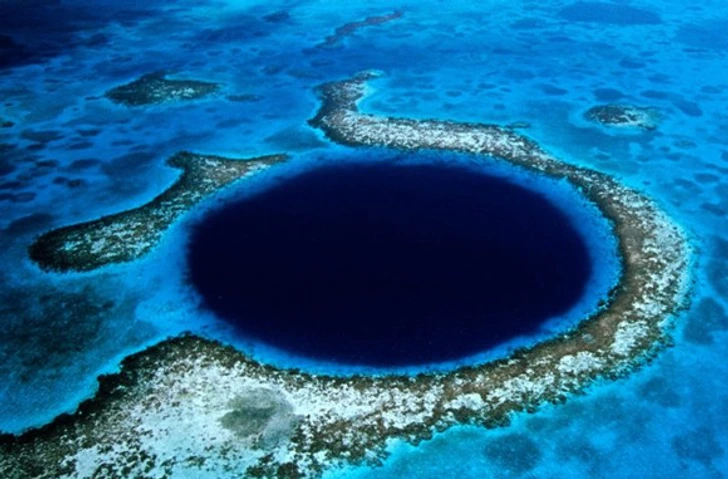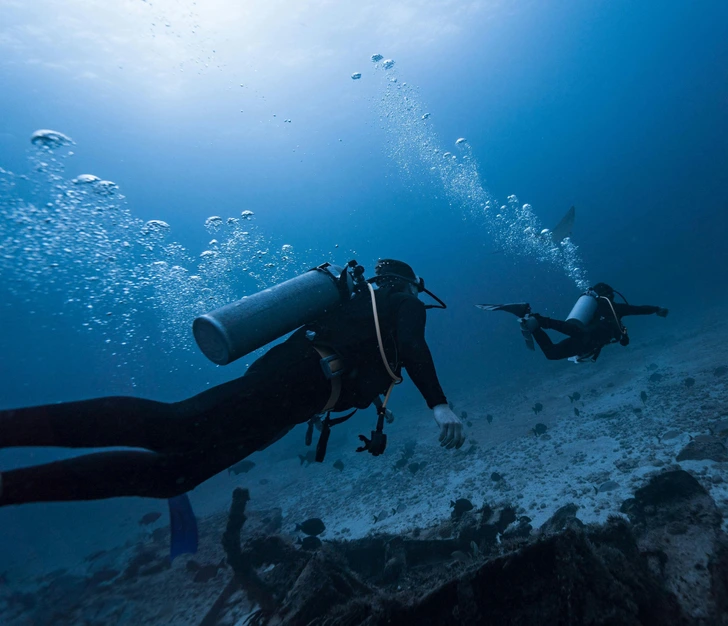The world is full of wonders, some of which remain shrouded in mystery, while others evoke a sense of awe and even fear. One such marvel is the Great Blue Hole, a massive underwater sinkhole located approximately 64 miles off the coast of Belize. This natural wonder, stretching 407 feet in depth, has captivated scientists, divers, and adventurers for decades. Over the years, some have dared to explore its depths, and the discoveries they made were both astonishing and unsettling.
Easily recognizable from above, the Great Blue Hole is a striking circular formation in the Caribbean Sea, surrounded by a vibrant coral reef. It gained worldwide recognition in 1971 when legendary explorer Jacques Cousteau set out to explore it, declaring it one of the best diving sites on the planet. His endorsement placed it firmly on the map for divers and marine enthusiasts alike.

Jacques Cousteau was not only an exceptional explorer but also a pioneer in marine conservation. He co-invented modern scuba diving equipment, enabling deeper and longer explorations beneath the waves. His groundbreaking underwater documentaries provided an unprecedented glimpse into the ocean’s hidden wonders and inspired generations to protect marine life. His legacy lives on through his grandson, Fabien Cousteau, who has continued to push the boundaries of ocean exploration.
In 2018, Fabien Cousteau, along with billionaire adventurer Richard Branson, undertook a daring mission to explore the depths of the Great Blue Hole. Using two submarines, they descended into the abyss, each moment revealing more about this mysterious geological formation. As they ventured deeper, the sunlight above grew fainter until they reached 300 feet below the surface, where they encountered an eerie layer of hydrogen sulfide. This thick, murky cloud cut off all light and oxygen, creating an uninhabitable void. Beyond this layer, the environment was entirely lifeless. What they discovered at the very bottom of the sinkhole was both surprising and sobering.
Amidst the rocky seabed, they found human-made trash—an unsettling reminder of humanity’s far-reaching impact on the planet. A single plastic bottle lay discarded at the bottom, serving as a stark symbol of pollution’s relentless reach, even into the most remote and untouched places on Earth. But that wasn’t the only unexpected find. A GoPro camera was also discovered, astonishingly intact, still containing footage from a past diver’s expedition. While this relic offered a fascinating glimpse into another explorer’s experience, it was also a somber testament to how easily human traces can linger in nature’s most pristine corners.
However, the most shocking discovery was not the trash—it was something far more haunting. At the bottom of the Great Blue Hole, the team found human remains. These were the bodies of divers who had gone missing years ago while exploring the depths of the sinkhole. The chilling discovery served as a sobering reminder of the risks that extreme diving entails. The team made the respectful decision to leave the remains undisturbed, notifying the Belizean government so that the appropriate authorities could handle the matter with the dignity and care it deserved.
The Great Blue Hole is not just a deep underwater pit; it holds secrets of the past. During their exploration, the team uncovered something remarkable—stalactites. These long, icicle-shaped mineral formations typically develop in dry caves over thousands of years, yet here they were, submerged deep beneath the ocean’s surface. This revelation provided undeniable evidence that the Great Blue Hole was once above sea level. Thousands of years ago, before being engulfed by rising waters, it had been a dry cave system.
Following the expedition, Richard Branson shared his reflections on what they had uncovered. He described the Great Blue Hole as an intricate network of caves that once existed on dry land before being submerged by the ocean. According to Branson, the site serves as a powerful testament to how quickly and dramatically sea levels can rise. He noted that, approximately 10,000 years ago, during a period of significant glacial melting, sea levels rose by around 300 feet, submerging vast portions of land. At 300 feet below the surface, one can see the distinct line where the terrain once stood above the water, marking a dramatic shift in Earth’s history. Branson called it one of the most vivid reminders of the dangers posed by climate change and the ongoing threats of rising sea levels.
The Great Blue Hole stands as a stark and mesmerizing reminder of our planet’s ever-changing nature. It also underscores the responsibility humans bear in protecting such natural wonders from environmental harm. Even in the most isolated corners of the world, the impact of human activity is evident. Plastic pollution, lost equipment, and the undeniable effects of climate change all paint a picture of a world that is struggling under the weight of human influence.

The discoveries made in the Great Blue Hole serve as both a scientific breakthrough and a cautionary tale. They reveal the history of Earth’s geological evolution while highlighting the pressing need to address environmental issues. Pollution, especially plastic waste, continues to threaten marine ecosystems, while climate change accelerates the loss of natural landscapes that have existed for thousands of years. As the planet’s inhabitants, it is up to us to take action, ensuring that places like the Great Blue Hole remain preserved for future generations to study, explore, and marvel at.
For adventurers and travelers seeking to witness the wonders of the world, the Great Blue Hole remains one of the most breathtaking destinations. Its sheer size and depth, coupled with the enigmatic beauty hidden beneath the surface, make it a site unlike any other. While it is a dream for experienced divers, it is also a location that commands respect and caution. The sinkhole’s extreme conditions have claimed lives, reinforcing the importance of proper preparation and awareness before embarking on deep-sea expeditions.
If you have ever been fascinated by the mysteries of the ocean, the Great Blue Hole is a place that embodies both the thrill of discovery and the sobering reality of our impact on nature. It is a site that tells a story—a story of a world that once was, a story of explorers daring to uncover the unknown, and a story of a planet that continues to change in ways we must learn to respect and protect.
There is no shortage of awe-inspiring places across the globe, each offering its own unique glimpse into Earth’s natural wonders. If the idea of uncovering hidden marvels excites you, there are countless destinations that deserve a spot on your bucket list. From towering mountains and lush rainforests to sprawling deserts and deep-sea trenches, our planet is filled with extraordinary places waiting to be explored. Whether you are drawn to the depths of the ocean or the peaks of the highest mountains, the wonders of the world are endless.

The Great Blue Hole is more than just a geological anomaly—it is a gateway to understanding the planet’s history, a reminder of nature’s power, and a call to action for conservation. As we move forward, it is crucial to recognize the importance of preserving such sites, ensuring that they remain intact for generations to come. Our actions today will determine the fate of these wonders, shaping the legacy we leave behind.
If you are someone who dreams of adventure, exploration, and uncovering the hidden gems of the world, then the Great Blue Hole should undoubtedly be on your list. It is a place that combines the thrill of the unknown with the reality of our planet’s fragile state. By embracing both its beauty and its lessons, we can become better stewards of the Earth, protecting its most precious places so that they may continue to inspire, educate, and amaze all who dare to explore them.





